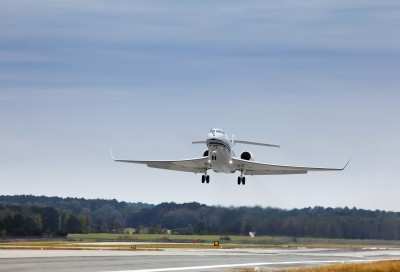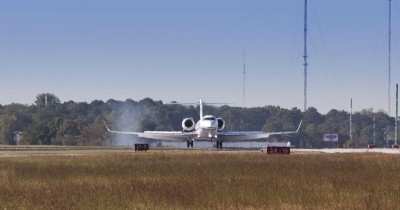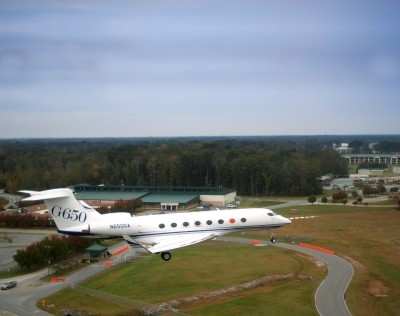Travels 5,000 Nautical Miles Nonstop At Mach 0.90 On Fifth Test
Flight
Just before the NBAA Meeting and Convention in Atlanta,
Gulfstream test pilots and engineers made a compelling
demonstration of the Gulfstream G650's exceptional high-speed
cruise capabilities, flying a 5,000-nautical-mile closed circuit at
Mach 0.90 over the Atlantic Ocean in 9 hours and 45 minutes.

G650 File Photo
"Never has a business jet flown so far, so fast, so flawlessly,"
said Pres Henne, senior vice president, Programs, Engineering and
Test, Gulfstream. "This airplane defines a new level of
productivity. Part of that is the ability to move executives in
comfort swiftly around the world."
Aircraft Serial Number (S/N) 6004, the fourth test aircraft in
the flight-test program, and the first with a full interior,
departed Savannah at 0957 EDT on October 9 for the fastest
ultra-long-range flight ever flown by a business jet. The aircraft
had flown a total of only 12 hours previously, including seven
hours with a fully installed interior. The jet is on display for
order holders at the NBAA industry conference in Atlanta this
week.
Weight at take-off was 99,538 pounds. The aircraft has a maximum
take-off weight of 99,600 pounds, allowing it to operate from
weight-restricted airports such as Teterboro and Aspen.
A crew of six manned the aircraft: Senior Experimental Test
Pilot Tom Horne; Production Test Pilots Al Moros and Rick Gowthrop;
Flight Test Engineer Michael Brinley; and Interior Specialists
Allen Blaylock and Mike Phipps. Blaylock and Phipps used the time
aloft to examine the new cabin installation under cold-soak
conditions, evaluating the many new features of the G650 cabin,
including communications and entertainment equipment and the
airplane's advanced Gulfstream Cabin Management System (GCMS).
Although six were aboard, the aircraft was ballasted to simulate
a crew of four and eight passengers.
Climb out was at 250 knots to 10,000 feet, then 300 knots,
transitioning to Mach 0.85 until reaching cruise altitude.
Twenty-three minutes after brake release, the aircraft leveled off
at its initial cruise altitude of 39,000 feet and accelerated to
Mach 0.90, later making step climbs to a final cruise altitude of
45,000 feet.
Due to the aircraft's experimental status and its current lack
of reduced vertical separation minimum (RVSM) approval, there were
some restrictions to the route that could be selected for a
high-speed demonstration. Therefore, the aircraft flew in an
offshore warning area in a 200- nautical-mile race-track pattern
with 70-mile turns flown at an approximate bank angle of 12
degrees. Temperature along the route was close to ISA with the
worst case being ISA+7.

G650 Landing In Atlanta
Descent was at Mach 0.90, transitioning to 300 knots and then
250 knots at 10,000 feet with a return landing with NBAA IFR
reserves in Savannah. "At those speeds, we could have been in
Buenos Aires for dinner, or in Hawaii for lunch due to the time
zone change" said Horne. "We continue to be impressed by the
reliability and capability of this airplane at this early stage in
its development."
The G650 has a range of 7,000 nm at Mach 0.85. It is the
largest, fastest, longest-range purpose-built business jet.
Certification is planned for 2011 with customer deliveries
beginning in 2012.
The speed demonstration was one of a number of tests being
performed on the aircraft as it moves towards that certification
date, and Gulfstream announced Monday that the aircraft recently
completed several tests required as part of its certification by
the FAA and EASA, including flutter, in-flight loads, flammable
fluid drainage and ingestion, and water ingestion.
Initial certification tests were conducted during envelope
expansion when the absence of flutter was shown out to the design
dive speed (Vd) and design Mach dive speed (Md). During these
tests, the aircraft achieved a top speed of Mach 0.995 and
demonstrated acceptable damping responses following an input from
an external test device.
In addition, certification data has been obtained for the
in-flight measurement of aerodynamics loads on the wing, tail and
fuselage.
The FAA began participating in certification testing of the G650
when it issued the first Type Inspection Authorization (TIA) in
late August. The document authorizes the regulatory agency to
conduct the tests required as part of the effort for the aircraft
to receive its type certificate, which Gulfstream anticipates
receiving in 2011. The FAA issued the TIA for the flammable fluid
drainage and ingestion test, which demonstrates that fluids will
drain properly from various zones around the aircraft and will not
accumulate in excessive quantities.

Gulfstream Plane View Flight Deck
"This shows that we've reached the point in the flight-test
program where FAA test crews are flying on the aircraft and
collecting the data necessary to support certification," said Barry
McCarthy, director, Flight Test, Gulfstream. "It also means that
our product development team has satisfied a number of engineering
pre-requisites. On all fronts, our test program is progressing in
support of our aircraft certification schedule."
The fluid drainage and ingestion testing was conducted using the
second aircraft in the flight-test program, Serial Number (S/N)
6002. After entering flight test on February 25, the aircraft
completed initial anti-skid brake tuning and ram-air turbine
testing. Earlier this year, the aircraft traveled to the Climatic
Testing Facility at Eglin Air Force Base to test component cooling
and system operations during weather extremes ranging from -40 to
55 degrees Celsius.
Since making its flying debut on November 25, 2009, S/N 6001 has
performed a number of tests, including aerodynamic stall testing to
validate low-speed limits and stall characteristics. It has also
been involved in parameter identification testing to validate the
aerodynamic models used for engineering analysis for control-law
development. The aircraft has also confirmed a wide range of data,
including minimum control air speeds, initial cruise performance,
and flight-control system/flight-control law performance. The
program's second TIA for water-ingestion tests was recently
completed at NASA's facility at Wallops Island, Va. These tests
demonstrated that on a runway with standing water, the aircraft and
engine operations were not appreciably affected by water
ingestion.
Since joining flight test in May, S/N 6003 has been used to
measure in-flight loads and validate the initial PlaneViewTM
avionics, auto-pilot and flight management systems.
"As the test program continues, the outstanding performance of
the flight-control and fly-by-wire systems has been one of the
highlights," said Pres Henne, senior vice president, Programs,
Engineering and Test, Gulfstream. "The absence of any serious
issues attests to the investment we made into the Iron Bird, a
ground-based test structure designed to replicate the actual
aircraft. The Iron Bird has allowed our engineers and suppliers to
verify and validate the system design requirements and identify and
resolve issues well in advance of the flight-test program."

G650 First Flight File Photo
For the first time, Gulfstream is also testing an aircraft
outfitted with a full interior. S/N 6004, which flew for the first
time June 6, had its interior installed over the summer and has
resumed flight test.
Since the flight-test program officially began on Novomber 29,
2010, the four aircraft in the program have accumulated more than
700 hours over more than 200 flights, as of October 12.
"We are encouraged at the overall reliability of the G650,"
Henne said. "As the test aircraft continue to fly, they are coming
back without squawks. That's a very good indication for our program
and customers."
Testing also continues in the G650 Integration Test Facility
(ITF) at Gulfstream's Savannah headquarters. Engineers have been
using the facility to integrate the software and hardware for the
aircraft's systems and to perform the human-factors testing
required for certification. For the first time in Gulfstream's
history, the ITF also includes a full-size mock-up of the G650
cabin systems to support Gulfstream's Cabin EssentialTM design
philosophy, which ensures that systems are designed with redundancy
to prevent single-point failure.
 ANN's Daily Aero-Linx (04.15.24)
ANN's Daily Aero-Linx (04.15.24) Classic Aero-TV: 'No Other Options' -- The Israeli Air Force's Danny Shapira
Classic Aero-TV: 'No Other Options' -- The Israeli Air Force's Danny Shapira Aero-News: Quote of the Day (04.15.24)
Aero-News: Quote of the Day (04.15.24) Airborne 04.16.24: RV Update, Affordable Flying Expo, Diamond Lil
Airborne 04.16.24: RV Update, Affordable Flying Expo, Diamond Lil ANN's Daily Aero-Term (04.16.24): Chart Supplement US
ANN's Daily Aero-Term (04.16.24): Chart Supplement US






